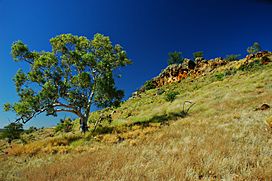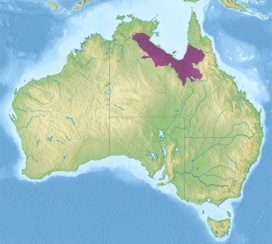Carpentaria tropical savanna facts for kids
Quick facts for kids Carpentaria tropical savanna |
|
|---|---|

Savanna at Riversleigh fossil site, near Lawn Hill, Queensland.
|
|

Ecoregion territory (in purple)
|
|
| Ecology | |
| Realm | Australasian |
| Biome | tropical and subtropical grasslands, savannas, and shrublands |
| Borders | |
| Geography | |
| Area | 365,042 km2 (140,944 sq mi) |
| Country | Australia |
| States | Northern Territory and Queensland |
| Conservation | |
| Conservation status | Relatively stable/intact |
| Protected | 24,914 km² (7%) |
The Carpentaria tropical savanna is a special natural area in northern Australia. It's a type of ecoregion where you'll find lots of grasslands and savannas. This means it has wide-open grassy areas with scattered trees. It's a really important home for many unique plants and animals.
Contents
Where is the Carpentaria Savanna?
This ecoregion is located in the northern parts of Queensland and the western parts of the Northern Territory. It lies just south of the Gulf of Carpentaria.
It includes a large part of Queensland's Gulf Country. It also covers some of the Barkly Tableland in the Northern Territory. Even some islands in the gulf, like the Wellesley Islands and Pellew Islands, are part of this area.
Many rivers flow through this region and empty into the Gulf of Carpentaria. These include the Roper, Limmen Bight, McArthur, Calvert, Nicholson, Leichhardt, Flinders, Norman, Gilbert, Staaten, and Mitchell rivers. Near the gulf, many of these rivers have areas of freshwater and saltwater wetlands.
The Carpentaria tropical savanna is surrounded by other natural regions. To the northeast is the Cape York Peninsula tropical savanna. To the east is the Einasleigh Uplands savanna. The Mitchell Grass Downs are to the south. To the west are the Victoria Plains tropical savanna and Kimberley tropical savanna. Finally, the Arnhem Land tropical savanna is to the northwest.
What is the Climate Like?
The Carpentaria tropical savanna has a tropical savanna climate. This means the weather changes a lot between seasons.
Most of the rain falls during the Southern Hemisphere summer. This is from November to March, when monsoon winds bring heavy rainfall. The rest of the year is a dry season.
The amount of rain generally decreases as you go from north to south. The northwestern part of the ecoregion gets the most rain, about 1000 to 1200 mm each year. Temperatures are usually warm all year round. Areas further from the coast have bigger differences between the highest and lowest monthly temperatures.
What Plants Grow Here?
The plants in this ecoregion include different types of grasslands, savannas, and open woodlands. There are also small areas of forest.
Along the western coast of the Gulf of Carpentaria, you'll find woodlands. These are mostly made up of Darwin stringybark (Eucalyptus tetrodonta) trees. Underneath these trees, you'll see grasses, especially curly spinifex (Triodia pungens).
Further inland, west and south of the coastal plain, there are more woodlands and savannas. Here, common trees include Darwin box (Eucalyptus tectifica) and long-fruited bloodwood (Corymbia polycarpa). Curly spinifex is still a common grass. In wetter areas, you might see tall Sorghum grasses, similar to those in the Arnhem Land tropical savanna.
South and southeast of the Gulf, the land is mostly open grasslands. These areas are covered in Dichanthium grasses, also known as bluegrass. In the southwestern part, there's a narrow strip of Eucalyptus and Melaleuca woodlands. These have a grassy layer mainly of Chrysopogon fallax.
Closer to the Einasleigh Uplands in the southeast, you'll find Eucalyptus woodlands. There are also low Melaleuca woodlands with Aristida spp. and Chrysopogon fallax grasses. On higher areas in the southeast, there are woodlands of narrow-leaved ironbark (Eucalyptus crebra) and Corymbia spp. (bloodwood). You can also find stands of lancewood (Acacia shirleyi) trees.
The rivers in this ecoregion create both freshwater and saltwater wetlands as they get close to the gulf. There are also many mangroves growing along the coast.
What Animals Live Here?
One special animal that lives only in this ecoregion is the Carpentarian rock rat (Zyzomys palatalis). It's found in small patches of forest and vine thickets. These areas are usually on sandstone rocks in a place called Wollogorang Station. This station is near the gulf in the Northern Territory, close to the border with Queensland.
Protected Areas
About 7% of the Carpentaria tropical savanna is protected land. This helps keep its unique plants and animals safe.
Some of the protected areas include:
- Limmen National Park
- Rutland Plains Nature Refuge
- Staaten River National Park
- Thuwathu-Bujimulla Indigenous Protected Area
- Nijinda Durlga Indigenous Protected Area
- Pungalina-Seven Emu Sanctuary
- Wongalara Sanctuary
- The southern part of South-East Arnhem Land Indigenous Protected Area
- The northern part of Boodjamulla National Park

